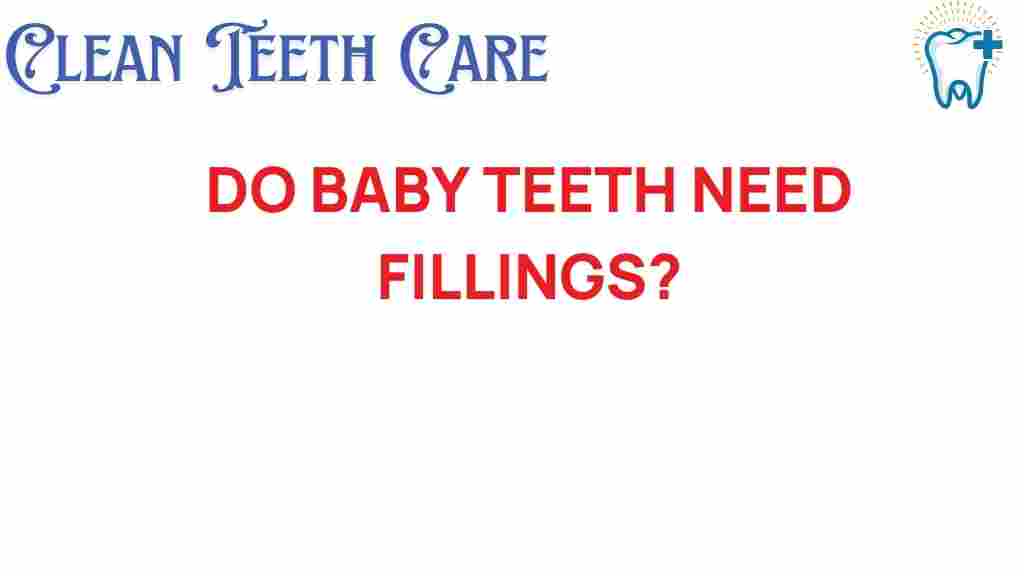The Surprising Truth: Do Baby Teeth Really Need Fillings?
When it comes to children’s health, many parents often wonder about the importance of baby teeth and whether issues like cavities necessitate fillings. Pediatric dentistry is a crucial aspect of maintaining oral hygiene in children, but there are many myths and misconceptions surrounding tooth decay in baby teeth. In this article, we will delve into the necessity of fillings for baby teeth, explore the implications of untreated cavities, and provide essential tips for preventive care.
Understanding Baby Teeth: Why They Matter
Baby teeth, also known as primary teeth, begin to emerge around six months of age and typically last until around age twelve. While they are eventually replaced by permanent teeth, their significance in a child’s development cannot be understated:
- Chewing and Nutrition: Baby teeth aid in proper chewing, which is critical for digestion and nutrition.
- Speech Development: They play a vital role in helping children articulate sounds and words.
- Jaw Development: The presence of baby teeth helps guide the growth of the jaw and the alignment of permanent teeth.
- Self-Esteem: Healthy baby teeth contribute to a child’s self-image and confidence.
The Importance of Filling Cavities in Baby Teeth
When a cavity forms in a baby tooth, it may seem tempting to ignore it since these teeth will eventually fall out. However, untreated cavities can lead to significant complications:
- Pain and Discomfort: Cavities can cause intense pain, affecting a child’s ability to eat, sleep, and concentrate.
- Infection Risk: Bacteria can spread from decayed teeth to other areas of the mouth, causing infections that may require more extensive treatment.
- Impacted Permanent Teeth: Untreated cavities can disrupt the proper alignment of emerging permanent teeth, leading to orthodontic issues.
- Impact on Overall Health: Oral health is directly linked to overall health; untreated dental issues can affect a child’s physical health.
Preventive Care for Baby Teeth
Preventive care is essential to maintain healthy baby teeth and prevent the need for fillings. Here are some practical tips:
- Regular Dental Check-ups: Schedule dental visits every six months to monitor your child’s oral health.
- Daily Brushing: Teach your child to brush their teeth twice a day with fluoride toothpaste.
- Healthy Diet: Limit sugary snacks and beverages that can contribute to tooth decay.
- Fluoride Treatments: Consult your pediatric dentist about fluoride treatments to strengthen enamel.
- Sealants: Dental sealants can provide an extra layer of protection for the chewing surfaces of molars.
When Are Fillings Necessary for Baby Teeth?
Deciding whether to fill a cavity in a baby tooth depends on several factors:
- Extent of Decay: If the cavity is small and caught early, a filling may be recommended.
- Location of the Tooth: Fillings may be necessary if the cavity is in a tooth that is crucial for chewing or speech.
- Child’s Age: Younger children may require fillings to prevent pain and complications.
- Potential for Future Issues: If the tooth is likely to affect the alignment or health of the permanent teeth, fillings are advised.
Types of Fillings Used in Pediatric Dentistry
In pediatric dentistry, several types of fillings can be used for baby teeth:
- Composite Resin Fillings: These tooth-colored fillings blend well with natural teeth and are often used for cavities in visible areas.
- Amalgam Fillings: Made from a mixture of metals, these are durable and commonly used for back teeth.
- Glass Ionomer Fillings: These release fluoride and are often used in children due to their ability to bond to the tooth structure.
Steps in the Filling Process
Here’s a step-by-step guide on what to expect during the filling process for baby teeth:
- Initial Examination: The dentist will examine the tooth and take X-rays to assess the extent of decay.
- Anesthesia: A local anesthetic may be administered to ensure the child is comfortable during the procedure.
- Decay Removal: The dentist will remove the decayed portion of the tooth using a dental drill.
- Filling Placement: The appropriate filling material is placed into the cavity and shaped to fit the tooth.
- Final Adjustments: The dentist will check the bite and make any necessary adjustments to ensure comfort.
Troubleshooting Tips for Parents
If your child has had a filling or is experiencing dental issues, here are some troubleshooting tips:
- Monitor for Pain: If your child complains of pain after a filling, contact your dentist immediately.
- Watch for Sensitivity: It is normal for the filled tooth to be sensitive for a few days, but persistent sensitivity should be evaluated.
- Maintain Oral Hygiene: Encourage your child to continue good oral hygiene practices after dental work.
- Follow-Up Visits: Keep up with regular dental visits to monitor the filled tooth and overall oral health.
Conclusion: Prioritizing Dental Care for Baby Teeth
In conclusion, the health of baby teeth is vital for a child’s overall well-being. While it may be tempting to overlook the need for fillings, the implications of untreated cavities can have lasting effects on children’s health and development. By prioritizing preventive care and maintaining a solid oral hygiene routine, parents can help ensure that their children have healthy smiles that last a lifetime.
For more information about pediatric dentistry and maintaining your child’s oral health, visit this resource.
Remember, investing in your child’s dental care today can lead to a brighter, healthier future!
This article is in the category Treatments and created by CleanTeethCare Team
